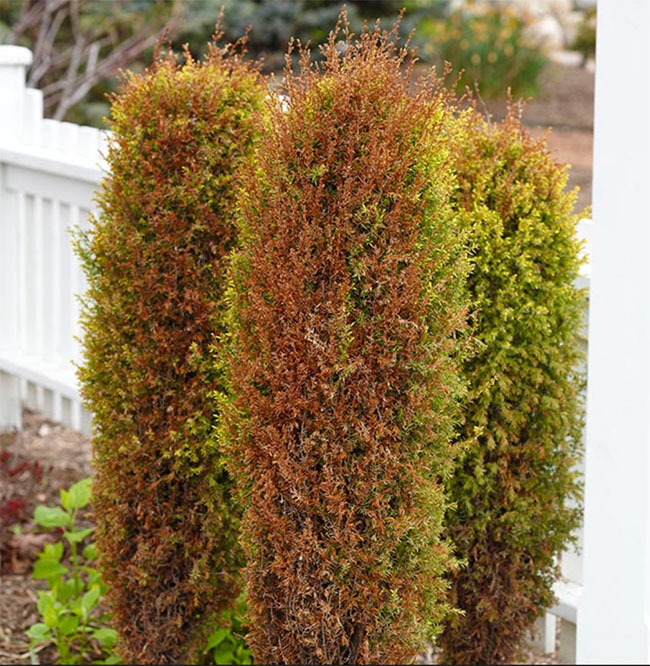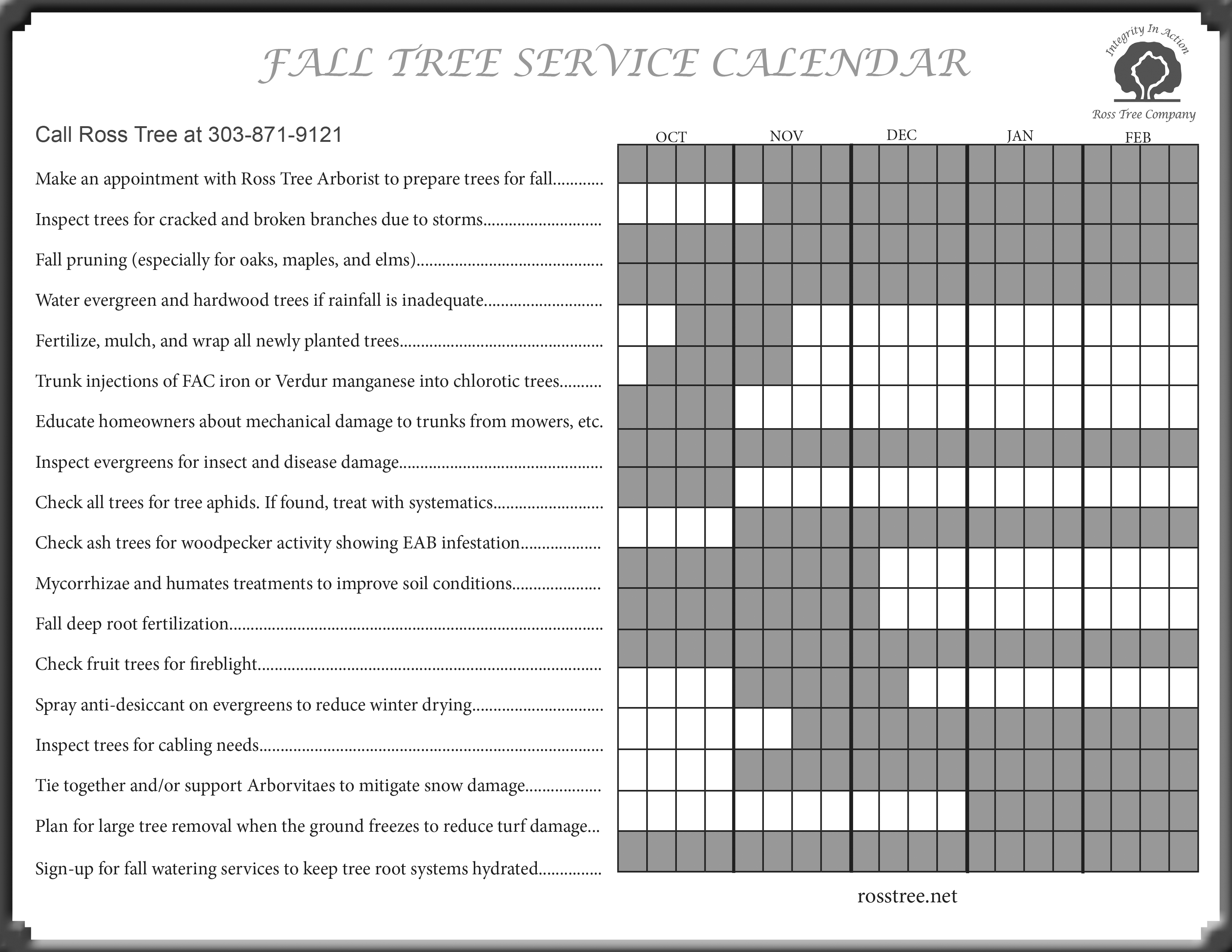Getting Trees Ready for The Fall
Fall tree service is probably the most optimal time for homeowners to care for their trees. The fall starts, or the autumnal equinox arrives on September 22. With the change in seasons, deciduous trees start cutting off nutrients to their leaves which causes them to change color and drop. They drop their leaves to conserve water in the winter. Yard trees that turn early are stressed and need immediate attention. Fall is the most crucial time to water and fertilize trees to promote healthy root systems that can resist Denver’s winter droughts. Many people do not realize that trees set their leave and flower buds in the fall. So, it is OK to prune trees during the colder months. Ross Tree’s General Manager discusses how to prepare trees as the weather turns cold.
Tree Pruning
A vital fall tree service activity is pruning. Yard trees grow every which way because of the abundance of sun and lack of competition. The first step is to develop and maintain a dominant leader in a tree. The arborist will cut out space between main branches and prevent branches from growing upright or too large to compete against the central leader. A strong leader increases tree stability and promotes healthy growth. After the leaves drop, it is much easier for arborists to see and remove any dieback, squirrel kill, insect, or disease damage. Also, fall pruning is an excellent time to trim back and remove any crossing branches to prepare trees for Denver’s unpredictable snow and wind storms.
Storm Damage Prevention
It is not usually for a foot of snow to drop in the City when trees are still leafed out, causing considerable tree damage across all neighborhoods. Do your trees a favor and get them trimmed in the fall by a tree service company, like Ross Tree, that has three certified arborists. Homeowners with storm-damaged trees should take the following steps to help their trees recover quickly:
- Damage Assessment
Homeowners should check their trees for broken branches, cracked bark, split trunks, or leaning. Even small trees that are bent present considerable danger to the unaware, so be careful cutting them. If it is a large tree, it is best to call a professional company to service the tree for safety reasons.
- Tree Pruning Plan
When a tree service company arrives on site, their arborist will diagnose the damage and present the homeowner a quote to remove damaged branches, stake any leaning trees, and cabling to improve stability. The arborist will recommend removal if the tree is beyond repair.
- Regular Watering
All trees in Denver benefit from periodic deep root watering and feeding because of our arid climate. Damaged trees need more watering and feeding to promote healing and reduce stress.
Fall Deep Root Watering and Feeding
Deep root watering is an important fall tree service activity because it maintains a tree’s vascular system, aids in healing the canopy, and helps elongate and establish the root system. Denver has had two consecutive winter droughts: a bone-dry April in 2022 and a hot summer. Lack of rain or snow is tough on trees because it damages trees’ vascular and root systems. In 2022, many Aspens and Honeylocust trees in Denver neighborhoods took the brunt of the drought stress and succumbed to Cytospora and Thyronectria cankers, respectively. Highly denuded trees will probably die in 2023 and need removal. All yard trees should be mulched in the fall to conserve water. Click here to check out our blog titled “2022 Summer Tree Insect and Disease Assessment.”
Newly Planted Trees
Denver’s arid climate is tough on newly planted trees, so they need watering every two weeks during the fall and winter. Dig down into the soil 3-8 inches outside the root area. If the dirt does not stick when rolled between fingers, it needs water; if it sticks, water later. Mulching around trees maintains soil moisture and regulates ground temperature throughout the fall and winter. Wrapping young trees protects them from sunscald in the winter. Sunscald happens because of our sunny winter days, which causes bark cells to become active. Freezing temperatures at night kill these cells, wounding or scalding the tree. Young trees need TLC for three years after planting.
Ips Beetle Outbreak in Denver
Another result of Denver’s two-year drought is an Ips Engraver Beetle outbreak in Spruce, Ponderosa, and Austrian Pines. Lack of moisture collapses the vascular systems of these trees, causing subsonic pops that these beetles hear. The male beetles land and bore into the trees, causing vascular system damage. They send out pheromones attracting droves of beetles to the tree. After mating, the females excavate chambers to lay eggs. After hatching, the larvae greatly expand the sapwood damage. Drought-stressed trees cannot flush the beetles out, so the damage spreads to other branches and neighboring trees. In large outbreaks, these insects will attack healthy trees. Deep root watering and spray treatments are the only way to save healthy trees. The watering enables the tree to ward off these insects themselves. Spraying kills the beetles as they land or emerge from the trees. Once the beetles enter a tree, there is no treatment. Ross Tree recommends two sprays per year to save high-value conifers. For more information about the Ips Beetle outbreak in Denver click here.
Aphids
Denver had a dry early spring with little snow. Then it rained a lot in late May and early June. Tree aphids thrive in these conditions and are found on Spruce and Maple trees in large numbers. The same holds this fall with Conifer Aphids growing on Pines, Rose of Sharon, and Oaks. In extreme situations, affected trees are developing unsightly black sooty mold. Click here for more information about Aphids
Chapstick for Trees
After two winter droughts, homeowners with evergreens should consider using anti-desiccants or chapstick for trees. The evergreen scrubs above are drying out and could benefit from an anti-desiccant treatment. Anti-desiccants sprayed on evergreen foliage form a soft, transparent, flexible film that protects leaves and needles from drying out during the winter. The film protects plants from drought, high winds, sunscald, winter kill, and salt damage. The following plants benefit from anti-desiccant treatments:
Broadleaf evergreens
- Hollies
- Rhododendrons
- Boxwood
- Laurels
- Andromeda
Conifers with needles
- Yew
- Pine
- Arborvitae
Do not apply anti-desiccants to trees with waxy coatings, such as blue spruce.
Fall Tree Service Calendar

Please download the Ross Tree Fall Tree Service Calendar for a list of to-dos.
Call 303-871-9121 or fill out a service request form if you need assistance. We will come out and assess your trees and identify any fall tree service issues. Our arborist will tailor any required pruning, insect treatment, and watering programs to get trees through the winter and prepare them for the upcoming growing season.



